History

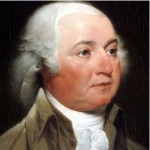 No country can truly be secure without an army, and the Thirteen Colonies (now the United States) was no different. After the beginning of the Revolutionary War, John Adams began to see the value of an army, so on June 10, 1775, he proposed to Congress, at a meeting in Philadelphia, that the men laying siege to Boston should be considered a Continental Army led by a general. The men who were mostly from New England, had armed themselves and rushed to surround British forces in Boston following the Battle of Lexington and Concord. Adams, who was representing Massachusetts, realized that the military effort would only succeed if the British thought the colonies were united. To achieve his united feel, Adams suggested than they appoint George Washington of Virginia, to command the Continental forces, despite the fact that New Englanders were used to fighting in local militias under officers elected from among their own ranks.
No country can truly be secure without an army, and the Thirteen Colonies (now the United States) was no different. After the beginning of the Revolutionary War, John Adams began to see the value of an army, so on June 10, 1775, he proposed to Congress, at a meeting in Philadelphia, that the men laying siege to Boston should be considered a Continental Army led by a general. The men who were mostly from New England, had armed themselves and rushed to surround British forces in Boston following the Battle of Lexington and Concord. Adams, who was representing Massachusetts, realized that the military effort would only succeed if the British thought the colonies were united. To achieve his united feel, Adams suggested than they appoint George Washington of Virginia, to command the Continental forces, despite the fact that New Englanders were used to fighting in local militias under officers elected from among their own ranks.
Five days later, on June 15th, Adams formally nominated George Washington as commander in chief of the Continental Army. Washington accepted the post on June 16th, and on June 17th, with no rest for the troops, the newly named army fought the Battle of Bunker Hill. John Adam’s wife, Abigail, and son, John Quincy Adams, watched the battle from their hometown of Braintree.
Just as the British had discovered the difficulties of waging war with rowdy and uncontrollable Yankees for soldiers during the Seven Years’ War, Washington was equally unimpressed when he met his supposed army. Just as the British had, he saw “stupidity” among the enlisted men, who were used to the easy familiarity of being commanded by neighbors. Upon arrival outside Boston, General George Washington organized this body of more than 22,000 men, known as the Main Army, into three divisions of two brigades each, promptly 
 insisting that the officers behave with decorum and the enlisted men with respect. Washington had some success with this first Continental Army, but when the New Englanders went home to their farms at the end of 1775, General Washington had to start fresh with new recruits in 1776. In retrospect, I’m sure Washington had better control over the second Continental Army, because they didn’t know any other leadership style. George Washington remained the commander of the Continental Army until the end of the Revolutionary War.
insisting that the officers behave with decorum and the enlisted men with respect. Washington had some success with this first Continental Army, but when the New Englanders went home to their farms at the end of 1775, General Washington had to start fresh with new recruits in 1776. In retrospect, I’m sure Washington had better control over the second Continental Army, because they didn’t know any other leadership style. George Washington remained the commander of the Continental Army until the end of the Revolutionary War.

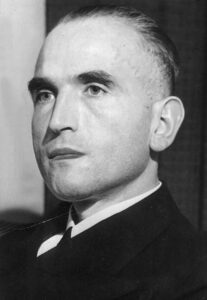 Not everyone was surprised at the coming murders of the Jews during the Holocaust. People hoped that the rumors were wrong, and that maybe they war would end before things got that bad, but most knew that if something wasn’t done, things were going to get ugly at some point. In the end, the non-Jews were forced to make a decision…take a stand, or stand by and watch millions of people die.
Not everyone was surprised at the coming murders of the Jews during the Holocaust. People hoped that the rumors were wrong, and that maybe they war would end before things got that bad, but most knew that if something wasn’t done, things were going to get ugly at some point. In the end, the non-Jews were forced to make a decision…take a stand, or stand by and watch millions of people die.
A Danish ambulance driver in Copenhagen, Denmark huddled over a local phone book, circling Jewish names. He had heard that all of Denmark’s Jews were going to be deported, and he knew this was his “moment of truth.” He knew he had to warn every one of these people, before it was too late. He wasn’t alone. Hundreds of everyday Danes sprang into action in late September 1943. They all had one collective goal in mind…to help their Jewish friends and neighbors escape the horrors they knew were coming.
The plan was amazing. Hundreds of people helped Jewish people sneak out of Copenhagen and other towns. They quickly headed toward Danish shores and into the crowded holds of tiny fishing boats. Denmark was about to pull off a spectacular feat…the rescue of the vast majority of its Jewish population. Within a few hours of learning that the Nazis intended to wipe out Denmark’s Jews, nearly all of the Danish Jews had gone into hiding. Within a few days, most of them had escaped Denmark to neutral Sweden. In the end, over 90% of the Danish Jews were snatched out of the hands of Adolf Hitler and his goons, and it was all thanks to ordinary Danes, most of whom refused to accept credit for their ations. I call it a miracle, and the participants…angels!!
The German forces invaded Denmark in April 1940. The Danish government, rather than suffer an inevitable defeat by fighting back, didn’t resist the Nazi hoard. Instead, the Danish government negotiated with the Germans to insulate Denmark from the occupation. In the negotiations, the Nazis promised to be lenient with the country, respecting its rule and neutrality…like they would ever keep that promise. By 1943, tensions had reached a breaking point. Workers began to sabotage the war effort and the Danish resistance ramped up their efforts to fight the Nazis. In response, the Nazis told the Danish government to institute a harsh curfew, forbid public assemblies, and punish saboteurs with death. The Danish government refused, so the Nazis dissolved the government and established martial law.
The Nazis had always been a forbidding presence in Denmark, but now they began really making their presence known. Like everywhere else, the Danish Jews were to be their first targets. The Holocaust was spreading across occupied Europe, and without the protection of the Danish government, which had done its best to shield Jews from the Nazis after realizing that the Nazi promises were worthless, Denmark’s Jewish population was in danger. In late September 1943, the Nazis got word from Berlin that it was time to rid Denmark of its Jews. As was typical for the Nazis, they planned the raid to coincide with a significant Jewish holiday…in this case, Rosh Hashanah, the Jewish New Year. Marcus Melchior, a rabbi, got word of the coming raid, and in Copenhagen’s main synagogue, he interrupted services. Melchior said, “We have no time now to continue prayers. We have news that this coming Friday night, the night between the first and second of October, the Gestapo will come and arrest all Danish Jews.” Melchior told the congregation that the Nazis had the names and addresses of every Jew in Denmark, and urged them to flee or hide.
Denmark’s panicked Jewish population sprang into action, but against all odds, so did its Gentiles. Hundreds of people spontaneously began to tell Jews about the upcoming action and help them go into hiding. It was, in the words of historian Leni Yahil, “a living wall raised by the Danish people in the course of one night.” It was amazing, and it can only be classified as a miracle. The Gentile people of Denmark were taking their lives into their own hands too, but they did not care, nor did they consider the cost. All they saw was the horrific injustice of the Nazi plan, and they could not abide by it.
No pre-existing plan had been put in place by the Danish people, but the Jewish people needed their help and nearby Sweden offered an obvious haven to those who were about to be deported. Sweden was still neutral and unoccupied by the Nazis, and they were a fierce ally. It was also close. Some areas of Denmark were just over three miles away from the Swedish coast. Once across, the Jews could apply for asylum there. The Danish culture has long been seafaring, in fact since Viking times. That said, there were plenty of fishing boats and other vessels to spirit Jews toward Sweden. But Danish fishermen were worried about losing their livelihoods and being punished by the Nazis if they were caught. So, rather than put their countrymen in peril, the resistance groups that swiftly formed to help the Jews managed to negotiate standard fees for Jewish passengers, then recruit volunteers to raise the money for passage. That way the fishermen got paid for their risk. The average price of passage to Sweden cost up to a third of a worker’s annual salary.
As often happens, there were fishermen who took advantage of the situation, but more who refused pay, acting without regard to personal gain. Boats were used for some 7,000 Danish Jews who fled to safety in neighboring Sweden. Passage was a terrifying ordeal. Jews gathered in fishing towns, hid on small boats, usually 10 to 15 at a time, giving their children sleeping pills and sedatives to keep them from crying, and struggled to maintain control during the hour-long crossing. Some boats, like the Gerda III, were boarded by Gestapo patrols. Gas came from strange sources. Careful rationing by groups like the “Elsinore Sewing Club,” a resistance unit, helped a few hundred Jews make the crossing.
There were failures sadly. In Gilleleje, a small fishing town, hundreds of refugees were being cared for by locals, when the Gestapo arrived. A collaborator had betrayed a group of Jews hiding in the town church’s attic. Eighty Jews were arrested. Others never got word of the upcoming deportations or were too old or incapacitated to seek help. In the end, about 500 Danish Jews were deported to the Theresienstadt ghetto. Of the 500 who were deported to the Theresienstadt ghetto, only 51 did not survive the Holocaust. Still, it was the most successful action of its kind during the Holocaust. Some 7,200 Danish Jews were ferried to Sweden.
The rescue was not without German help either. God can reach people even in such a corrupt government. Werner Best, the German who had been placed in charge of Denmark, apparently tipped off some Jews to the 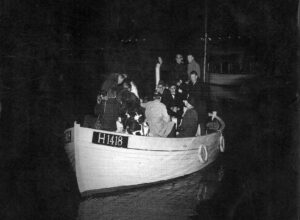
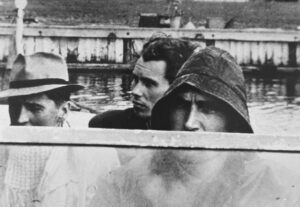 upcoming action and subtly undermined the Nazis’ attempts to stop the Danes from helping Danish Jews. Another helpful factor was that Denmark was one of the only places in Europe that had successfully integrated its Jewish population. Although there was anti-Semitism in Denmark before and after the Holocaust, the Nazis’ war on Jews was largely viewed as a war against Denmark itself.
upcoming action and subtly undermined the Nazis’ attempts to stop the Danes from helping Danish Jews. Another helpful factor was that Denmark was one of the only places in Europe that had successfully integrated its Jewish population. Although there was anti-Semitism in Denmark before and after the Holocaust, the Nazis’ war on Jews was largely viewed as a war against Denmark itself.
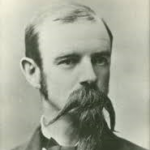
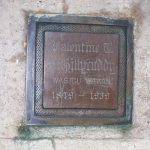
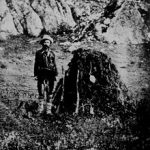 Valentine Trant O’Connell McGillycuddy was born on February 14, 1849 in Racine, Wisconsin to Irish immigrants Daniel McGillycuddy (1821–1892), a merchant, and Joana (Trant) McGillycuddy (1813–1892). His brother, Francis was 6 years older than he was. The McGillycuddy family moved to Detroit when Valentine was 13. At 20 years of age, McGillycuddy graduated from the Detroit Medical School. He began working as a doctor at the Wayne County Insane Asylum and practiced medicine for one year, a job that nearly drove him crazy…literally. Next, he began teaching at the medical college. His longstanding love for the outdoors eventually led McGillycuddy to leave the city medical field. At the request of Army engineer, General Cyrus Comstock, McGillycuddy surveyed and mapped the Great Lakes and Chicago’s devastation after the Great Fire. He probably could have stayed and continued working for the Army in the Great Lakes area, but his heart was in the West.
Valentine Trant O’Connell McGillycuddy was born on February 14, 1849 in Racine, Wisconsin to Irish immigrants Daniel McGillycuddy (1821–1892), a merchant, and Joana (Trant) McGillycuddy (1813–1892). His brother, Francis was 6 years older than he was. The McGillycuddy family moved to Detroit when Valentine was 13. At 20 years of age, McGillycuddy graduated from the Detroit Medical School. He began working as a doctor at the Wayne County Insane Asylum and practiced medicine for one year, a job that nearly drove him crazy…literally. Next, he began teaching at the medical college. His longstanding love for the outdoors eventually led McGillycuddy to leave the city medical field. At the request of Army engineer, General Cyrus Comstock, McGillycuddy surveyed and mapped the Great Lakes and Chicago’s devastation after the Great Fire. He probably could have stayed and continued working for the Army in the Great Lakes area, but his heart was in the West.
In 1875 he joined the US Geological Survey sponsored Newton-Jenney Expedition to the Black Hills. This trip would set the course for the rest of his life. Part scientific exploration, part treasure hunt, the expedition was fueled by the trip George Armstrong Custer made into the land of the Lakota and the reports of gold he brought back. Following that trip, McGillycuddy was appointed as the Army surgeon at Nebraska’s Fort Robinson and later administrator at Nebraska’s Red Cloud Agency in 1877. That appointment led to a friendship with Crazy Horse, and antipathy toward Red Cloud, both powerful leaders of the Dakota plains.
McGillycuddy had an uncanny knack for being at the right place at the right time, which put him right in the middle of things during the most consequential era of the American frontier. He met, treated, befriended, or opposed some of its most iconic figures including Little Big Horn principals, George Armstrong Custer, General George Crook, and Major Mark Reno, as well as Buffalo Bill Cody, Wild Bill Hickok, Calamity Jane Canary, the legendary Sioux chiefs Sitting Bull and American Horse, and John Wesley Powell…the man who mapped the Grand Canyon.
It also placed him squarely in the middle of a deadly struggle between the young upstart, Crazy Horse and the dominant chief of the Oglala Lakota, Red Cloud. The two were on different sides of just about everything. Crazy Horse resisted Anglo-American incursion at every turn, taking part in nearly every important battle including the Little Big Horn and the subsequent Dakota War. Red Cloud, who signed the 1851 Treaty of Fort Laramie, was deeply disappointed in the outcome. After having his own war named for him, Red Cloud’s War of 1866, he was finally willing to go along to get along. He and his band settled on the reservation, where he squabbled with Dr John J Saville, the government’s agency man.
McGillycuddy was at Fort Robinson when Crazy Horse surrendered in 1877. The move may have partially been prompted by his wife’s illness. McGillycuddy successfully treated Black Shawl. Some say she had tuberculosis and others claim it was cholera, which killed her three-year-old daughter. Whatever her ailment, saving her life brought about a close bond between Crazy Horse and the doctor. Six months after he surrendered, Crazy Horse was dead. Many people think he was assassinated, stirring a controversy that remains unresolved to this day. McGillycuddy spent the the wounded Crazy Horse’s last hours at his bedside. Varying accounts of the incident were provided by eye witnesses. Army Private William Gentles, an Irish immigrant soldier with a sketchy military career is a prime candidate for the killing of Crazy Horse, stabbing him with a bayonet. The Army’s retelling has Crazy Horse challenging the guards with two concealed knives as they attempted to lock him up, however. In the struggle, he fell on his own weapon. This version was attributed to Charging Bear, the real life “Little Big Man.” He is depicted as either a Crazy Horse lieutenant and “Shirt Wearer,” or a jealous rival who sought to curry favor with his Army captors. A number of Lakota genealogists lean heavily toward the latter, describing him as manipulative. He received a medal for his involvement in the incident.
McGillycuddy certified that his friend, Crazy Horse died near midnight on September 5, 1877, saying his killing “absolutely inexcusable.” Little Big Man was just part of the conspiracy. Crazy Horse was surrounded by shadowy characters. French and Lakota translator, William Garnett, thought that Little Big Man was the killer, but more than a dozen witnesses say an Army guard, perhaps Gentles, stabbed Crazy Horse. In the aftermath, Garnett was labeled a spy. Supposedly Garnett had no connection to Red Cloud, but Nellie Larrabee did. It was speculated that perhaps married to Crazy Horse, Larrabee, known as Chi Chi and Brown Eyed Woman, was sent to the Crazy Horse, Black Shawl household by Red Cloud. It was thought that she was there to act as a spy. Red Cloud was definitely not a fan of Crazy Horse. He thought his resistance to US forces was detrimental to the Lakota cause, but Red Cloud may have also been jealous of the attention the Army gave him. And then things got complicated. Red Cloud and Spotted Tail, a relative of Black Shawl, joined forces against the government’s attempts to seize tribal lands. Spotted Tail approved the Fort Laramie Treaty but continued to fight for sovereignty when the terms of the treaty were not met. Like Red Cloud, he believed it was a fool’s errand to oppose the government on the battlefield.
Along with Garnett, many Lakota deeply mistrusted Larrabee, calling her an “evil woman,” who helped lead Crazy Horse into a “domestic trap” that eventually caused his downfall and placed Spotted Tail in a Red Cloud conspiracy, as well. Others say Spotted Tail was unaware of any plot against Crazy Horse. After Crazy Horse died, McGillycuddy was named the Indian Agent on the Pine Ridge. His old enemy, Red Cloud had a hand to his downfall, accusing him of mismanagement and wrongdoing. A number of investigations were launched into the claims. Still McGillycuddy did his job, and amid charges of “tyranny” and fraud, he established a reservation police force and a boarding school. The breaking point came when the doctor was ordered to fire an otherwise blameless clerk. Rather than do so, he resigned his position in October of 1882 and moved with his wife Frances “Fanny” (Hoyt) McGillycuddy to Rapid City.
It was the end of an era. McGillycuddy served as Dean of the South Dakota School of Mines and Technology and was appointed South Dakota’s first State Surgeon. He was elected Rapid City mayor in 1897, but when Fanny died, he moved to California. Later, he married Julia Blanchard and enlisted at the start of World War I, serving Alaska and the western states during the 1918 Spanish Flu pandemic. His nemesis, Red Cloud, the last and one of the best known Lakota leaders, outlived nearly all of them. He died on the Pine Ridge Reservation, December 10, 1909 at 87 after converting to Christianity. He claimed the government had made many promises, but kept only one, saying, “They promised to take our land…and they took it.” There are 128 known photographs of Red Cloud, none of Crazy Horse, save a latter-day image found in a derelict photo studio in Chadron, Nebraska. It is still unverified. Black Shawl died in 1927, presumably of influenza. Helen “Nellie” Larrabee is believed to have died in about 1880. One source lists her burial in Charles Mix County near the present day Lake Andes, South Dakota.
Valentine McGillycuddy died on June 6, 1939, at the age of 90. Flags were lowered to half staff on the Pine Ridge at the news of his passing and his ashes were interred on Black Elk Peak in the Black Hills. Formerly known as Harney Peak, he had scaled the mountain as a young surveyor with the Newton-Jenney expedition. A simple stone monument reads “Valentine T. McGillycuddy, Wasicu Wakan, (Holy White Man) 1849-1939.” 

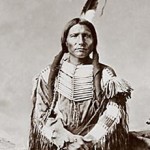 Valentine McGillycuddy’s grave site, Custer State Park, South Dakota, is accessible only by hiking trails, the most commonly used is Trail No. 9, from the Sylvan Lake Day Use Area. It is a site my husband, Bob and I have visited 15 times over the years. The three-mile hike through the ponderosa pine leads to the former fire tower atop what is now Black Elk Peak.
Valentine McGillycuddy’s grave site, Custer State Park, South Dakota, is accessible only by hiking trails, the most commonly used is Trail No. 9, from the Sylvan Lake Day Use Area. It is a site my husband, Bob and I have visited 15 times over the years. The three-mile hike through the ponderosa pine leads to the former fire tower atop what is now Black Elk Peak.
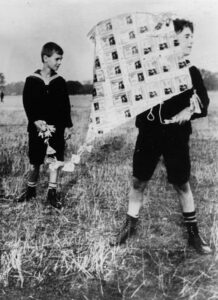
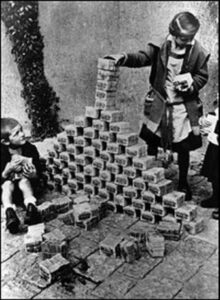 When inflation spirals out of control, as in post-World War I Germany, the country’s money soon becomes almost worthless. In 1923, when a battered Germany was struggling to recover from the war, the country was beset with hyperinflation and the German Mark became just that…virtually worthless. At one point, 4.2 trillion German marks was worth just one American dollar. Germany gradually spiraled into such an economic catastrophe that, by November 1923, the German Mark had so degraded that it took 200 billion Marks to buy a loaf of bread. No one in Germany had that kind of money. It was a disaster, and it brought about a number of bizarre events that would shock anyone who has never lived through it.
When inflation spirals out of control, as in post-World War I Germany, the country’s money soon becomes almost worthless. In 1923, when a battered Germany was struggling to recover from the war, the country was beset with hyperinflation and the German Mark became just that…virtually worthless. At one point, 4.2 trillion German marks was worth just one American dollar. Germany gradually spiraled into such an economic catastrophe that, by November 1923, the German Mark had so degraded that it took 200 billion Marks to buy a loaf of bread. No one in Germany had that kind of money. It was a disaster, and it brought about a number of bizarre events that would shock anyone who has never lived through it.
At some point people began to realize that they couldn’t buy anything with the money, so maybe the money needed to have a different use. One woman decided that since she didn’t have enough money for material to make a dress, she would use money to make the dress. Children were allowed to use stacks of banknotes to play with like blocks, and children made kites out of cash. Some people had an even better use for the money. They burned it for fuel. While all that might seem “funny,” not every effect was “funny.” One effect of the disaster was the destruction of middle class people’s savings, and Adolf Hitler exploited that one. He wasn’t having any financial difficulties, because he had control pf everything.
The crisis began during the First World War, when the German government printed unbacked currency and borrowed money to finance its dream of conquering Europe. It is always dangerous to print money with no gold to back it up. The government had an ingenious plan, however. They planned to pay off the debts by seizing resource-rich territories and imposing reparations on the vanquished Allies. I suppose that might have worked if they had not been beaten into submission in 1918. Then, Germany ended up with enormous debts alongside huge, punitive reparations owed to the Allies under the Treaty of Versailles. Inflation crept up slowly at first, before accelerating rapidly in late 1922. By autumn 1923, the country was in full economic collapse. The rate of inflation was 3,250,000% a month and prices for daily commodities doubled in a matter of hours.
During the crisis, workers paid by the hour found their wages were essentially worthless, because the prices had risen since they began their shifts. Pensioners on fixed incomes were the most badly hit and people’s life savings suddenly became worth less than a loaf of bread. Farmers eventually refused to bring produce into the city as the requirements to calculate and recalculate commercial transactions in the billions and trillions made it practically impossible to do business in cash. Storekeepers couldn’t do business fast enough to protect their cash receipts, so shops were abandoned. As people went through more and more panic situations, it led to uprisings. A far-left workers’ revolt in the industrial Ruhr region led to a 50,000-man ‘Red Army’ which took control of the area before being put down by the army. Adolf Hitler and the Nazi Party also attempted a failed government takeover in Munich, which became known as the Beer Hall Putsch.
The fever of hyperinflation finally broke in late 1923, when the government began issuing the new Rentenmark. The Rentenmark was a currency that was backed by mortgages on agricultural and industrial land, which was 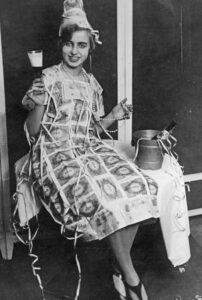
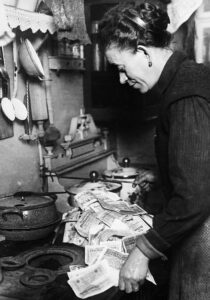 introduced with the old exchange rate of one US dollar to 4.2 Rentenmarks. It was a much more manageable difference for the people. The new currency’s foundation was shaky at best, but after going through years of terrifying instability, the German people were just desperate enough to trust it. Still, the German middle-class had been essentially ruined by the fiasco. The worst side-effect of the hyperinflation fiasco was that many members of the ruined middle classes ultimately became receptive to extremist propaganda, with many flocking to Adolf Hitler and the Nazi Party, as well as other anti-human ideologies like Communism. Sadly, when the system that they had been comfortable with failed because of the corruption of its leaders, they made the biggest mistake of all, they turned to the worst alternative as their new form of hope. That would prove an even bigger disaster in the coming World War II.
introduced with the old exchange rate of one US dollar to 4.2 Rentenmarks. It was a much more manageable difference for the people. The new currency’s foundation was shaky at best, but after going through years of terrifying instability, the German people were just desperate enough to trust it. Still, the German middle-class had been essentially ruined by the fiasco. The worst side-effect of the hyperinflation fiasco was that many members of the ruined middle classes ultimately became receptive to extremist propaganda, with many flocking to Adolf Hitler and the Nazi Party, as well as other anti-human ideologies like Communism. Sadly, when the system that they had been comfortable with failed because of the corruption of its leaders, they made the biggest mistake of all, they turned to the worst alternative as their new form of hope. That would prove an even bigger disaster in the coming World War II.

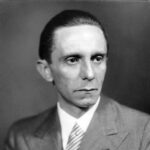 When the government forces a persecuted people to wear a label, that lets everyone around them know that they are a part of the group that anyone can persecute, it becomes one of the greatest atrocities known to mankind. Imagine a world where anyone has the right to beat, maim, and even kill another person in broad daylight and in front of witnesses, and face no repercussions for the atrocity committed. That was exactly the situation the Jewish people faced when, on May 29, 1942, on the advice of Nazi propaganda minister Joseph Goebbels, Adolf Hitler orders all Jews in occupied Paris to wear an identifying yellow star on the left side of their coats.
When the government forces a persecuted people to wear a label, that lets everyone around them know that they are a part of the group that anyone can persecute, it becomes one of the greatest atrocities known to mankind. Imagine a world where anyone has the right to beat, maim, and even kill another person in broad daylight and in front of witnesses, and face no repercussions for the atrocity committed. That was exactly the situation the Jewish people faced when, on May 29, 1942, on the advice of Nazi propaganda minister Joseph Goebbels, Adolf Hitler orders all Jews in occupied Paris to wear an identifying yellow star on the left side of their coats.
Most people, these days, can keep their beliefs to themselves, so they aren’t persecuted. We see it all the time. There are people right now, who don’t tell anyone that they are Christian (or Jewish) because they know that they will be hated, belittled, and persecuted simply because of their beliefs. It is against the law to murder…at this time, but it could change if we aren’t carful with the things we allow. This would be terrible, but nothing like the Yellow Star mandate was to the Jewish people. Hitler, along with his fellow government officials wanted 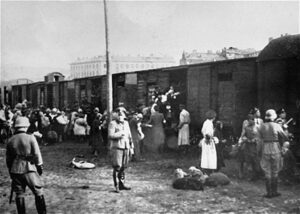 to dehumanize the Jewish people. One man, Joseph Goebbels, led the way on this. Goebbels had made the persecution, and ultimately the extermination, of Jews a personal priority from the earliest days of the war, often recording in his diary such statements as, “They are no longer people but beasts,” and “[T]he Jews… are now being evacuated eastward. The procedure is pretty barbaric and is not to be described here more definitely. Not much will remain of the Jews.” His hatred of the Jewish people was unrestrained.
to dehumanize the Jewish people. One man, Joseph Goebbels, led the way on this. Goebbels had made the persecution, and ultimately the extermination, of Jews a personal priority from the earliest days of the war, often recording in his diary such statements as, “They are no longer people but beasts,” and “[T]he Jews… are now being evacuated eastward. The procedure is pretty barbaric and is not to be described here more definitely. Not much will remain of the Jews.” His hatred of the Jewish people was unrestrained.
It is sad to think of this, and we can try to place the full blame on Hitler, Goebbels, or even the Nazis, but they were not the first to suggest this particular form of isolation. “The yellow star may make some Catholics shudder,” wrote a French newspaper at the time. “It renews the most strictly Catholic tradition.” Intermittently, throughout the history of the papal states, which is the territory in central Italy controlled by the pope, Jews were often confined to ghettoes and forced to wear either yellow hats or yellow stars. On July 14, 1555, Pope Paul IV issued the papal decree Cum Nimis Absurdum, which subjected Jews under his dominion to myriad 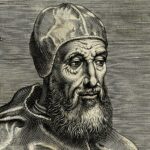
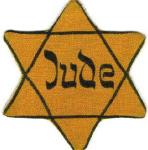 restrictions and humiliations, most notably forcing them to live in ghettos. He was an unusually rigid and anti-Jewish pope and this decree was one of his first actions, issued just two months after becoming pope. He also required that the ghettos be locked at night, the Jews were not allowed to own property and were required to identify themselves by wearing a yellow head covering. They were limited to primarily low-level trade jobs, and Jewish doctors were not allowed to have Christian patients. Nevertheless, Hitler’s Holocaust was the worst example of hatred imposed on the Jews in modern times.
restrictions and humiliations, most notably forcing them to live in ghettos. He was an unusually rigid and anti-Jewish pope and this decree was one of his first actions, issued just two months after becoming pope. He also required that the ghettos be locked at night, the Jews were not allowed to own property and were required to identify themselves by wearing a yellow head covering. They were limited to primarily low-level trade jobs, and Jewish doctors were not allowed to have Christian patients. Nevertheless, Hitler’s Holocaust was the worst example of hatred imposed on the Jews in modern times.
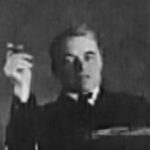
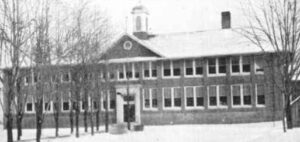 It’s said that there is nothing more dangerous than a humiliated man, and I suppose that could be true, but in the case of Andrew Kehoe, I think there was more to it than just one humiliation. Kehoe had shown violent tendencies since he was a child. Now, I’m not saying that every angry child will grow up to be a monster, but it might be something to monitor. If the violence becomes worse with age, there could be something wrong that needs to be addressed.
It’s said that there is nothing more dangerous than a humiliated man, and I suppose that could be true, but in the case of Andrew Kehoe, I think there was more to it than just one humiliation. Kehoe had shown violent tendencies since he was a child. Now, I’m not saying that every angry child will grow up to be a monster, but it might be something to monitor. If the violence becomes worse with age, there could be something wrong that needs to be addressed.
Andrew Philip Kehoe was born on February 1, 1872 in Tecumseh, Michigan. He was part of a large family. Kehoe showed violent tendencies early on. He tended to blame others for his troubles, which I think is also a common trait in troubled people. Kehoe was notified in June 1926 that his mortgage was going into foreclosure. Andrew Kehoe had been on the school board as treasurer. After his defeat in the April 5, 1926, election for the township clerk Kehoe lost it. Because of his association with the school board, Kehoe set his sights on the Bath School as a target to voice his frustrations. It was the last straw. Kehoe began secretly buying explosives. He hid them on 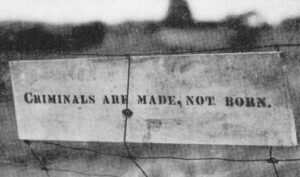 his father’s farm and under the school. On May 18, 1927, Kehoe murdered his wife Nellie Price Kehoe. He then blew up his farm, saying to the firemen as he drove away that they should go to the school instead. Then Kehoe drove off.
his father’s farm and under the school. On May 18, 1927, Kehoe murdered his wife Nellie Price Kehoe. He then blew up his farm, saying to the firemen as he drove away that they should go to the school instead. Then Kehoe drove off.
Kehoe made a sign and hung it on the fence at his farm, saying “Criminals are made, not born.” It was typical of his belief that all of his troubles could logically be blamed on other people, or even on chance events. He never took the blame for his problems himself. Following the bombing of his farm, Kehoe went on to set off the bombs that he hoped would completely destroy the Bath school, and kill everyone in it. Kehoe was disappointed to see that an additional 500 pounds of dynamite that had been set to go off at the same time as the other explosions, failed to detonate. Only a section of the front of the school blew up. Nevertheless, it was enough to kill 38 students and 6 teachers. To this day, the Bath School Massacre remains the deadliest school disaster in history, and it came long before the recent school disasters that so many blame on guns. No guns were used, except maybe to kill his wife, but there is no mention of that in the stories of this disaster either. After the bombing of his farm and the Bath School, Kehoe detonated more explosives in his truck killing himself and four other bystanders. Andrew P Kehoe was a local farmer and school board treasurer. Kehoe was well educated, respected, 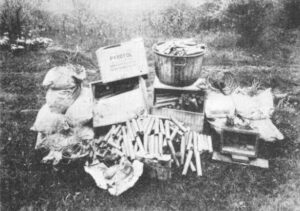
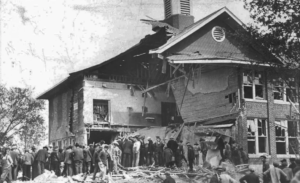 and was an accommodating neighbor and friend. But behind his ordinary demeanor was a narcissistic sadist seething with rage, resentment, and paranoia. To say that something in his life was to blame for his rage is really far fetched. To say that he was mentally ill might be more accurate. It’s hard to say if counseling could have helped either. It is something we will never know.
and was an accommodating neighbor and friend. But behind his ordinary demeanor was a narcissistic sadist seething with rage, resentment, and paranoia. To say that something in his life was to blame for his rage is really far fetched. To say that he was mentally ill might be more accurate. It’s hard to say if counseling could have helped either. It is something we will never know.
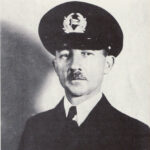
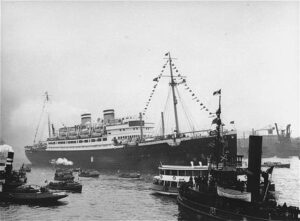 When Hitler’s reign of terror began, and the Jewish people soon realized that his goal was to wipe them from the face of the Earth, there was a mad scramble to get out of Germany and any other nation that was under Hitler’s control. Some people stayed, thinking that the war would be over soon, and many of those died. Others saw the writing on the wall, and started making plans to escape before it was too late.
When Hitler’s reign of terror began, and the Jewish people soon realized that his goal was to wipe them from the face of the Earth, there was a mad scramble to get out of Germany and any other nation that was under Hitler’s control. Some people stayed, thinking that the war would be over soon, and many of those died. Others saw the writing on the wall, and started making plans to escape before it was too late.
On May 27, 1939, a ship carrying 937 Jewish refugees was for the most part, turned away from Havana, Cuba, after admitting roughly 28 people onboard that had valid visas or travel documents. In my opinion, that was probably a blessing for those turned away, because as we all know, Cuba is not really they place that many people want to live. Nevertheless, it was a huge disappointment to the 909 Jewish refugees still on board. For seven days, the ship’s captain, Gustav Schröder, attempted to negotiate with Cuban officials, but they refused to comply. He then appealed to the United State and Canada for entry, and was also denied.
The SS Saint Louis had set sail on May 13, 1939 from Hamburg, Germany to Havana, Cuba. Six months earlier, 91 people were killed and Jewish homes, businesses, and synagogues were destroyed in what became known as the Kristallnacht massacre. It was becoming increasing clear that the Nazis were accelerating their efforts to exterminate Jews by arresting them and placing them in concentration camps. World War II and the formal implementation of The Final Solution were just months from beginning. Before they set sail, the refugees had applied for US visas, and planned to stay in Cuba until they could enter the United States legally. The Cuban government was not pleased with the planned stay in Cuba…even if it was temporary. Their impending arrival was greeted with hostility in Cuba before they even set sail. On May 8, there was a massive anti-Semitic demonstration in Havana. Right-wing newspapers claimed that the incoming immigrants were Communists.
The ship sailed closer to Florida, hoping to disembark there, but it was not permitted to dock. Some passengers attempted to cable President Franklin D Roosevelt asking for refuge, but he never responded. A State Department telegram stated that the asylum-seekers must “await their turns on the waiting list and qualify for and obtain immigration visas before they may be admissible into the United States.” As a last resort, the Saint Louis continued north to Canada, but it was rejected there, too. “No country could open its doors wide enough to take in the hundreds of thousands of Jewish people who want to leave Europe: the line must be drawn somewhere,” Frederick Blair, Canada’s director of immigration, said at the time.
After exhaustive appeals failed, the refugees were faced with no other options, the ship returned to Europe. On 
 June 17, the SS Saint Louis docked in Antwerp, Belgium. By the time they arrived, several Jewish organizations had secured entry visas for the refugees in Belgium, France, the Netherlands and Great Britain. The majority of the refugees who had traveled on the ship survived the Holocaust, but 254 died as the Nazis swept through Europe during Hitler’s horrible reign.
June 17, the SS Saint Louis docked in Antwerp, Belgium. By the time they arrived, several Jewish organizations had secured entry visas for the refugees in Belgium, France, the Netherlands and Great Britain. The majority of the refugees who had traveled on the ship survived the Holocaust, but 254 died as the Nazis swept through Europe during Hitler’s horrible reign.

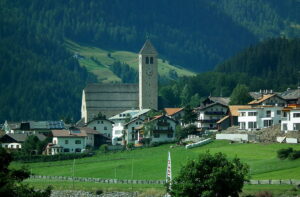 Curon Venosta was a village in northern Italy located in South Tyrol. Curon Venosta’s disappearance was not a mystery. The village suffered the same fate as numerous other towns over the years. The alpine village fell victim to the formation of a large man-made lake. The land was purchased and alpine village inundated shortly after World War II due to the construction of a dam. The officials had decided that they would join two smaller per-existing lakes into one large man-made lake.
Curon Venosta was a village in northern Italy located in South Tyrol. Curon Venosta’s disappearance was not a mystery. The village suffered the same fate as numerous other towns over the years. The alpine village fell victim to the formation of a large man-made lake. The land was purchased and alpine village inundated shortly after World War II due to the construction of a dam. The officials had decided that they would join two smaller per-existing lakes into one large man-made lake.
Originally, plans were made to make a smaller artificial lake dated back to the year 1920. Then, in July 1939 a new plan was introduced for a 75 foot deep lake, which would unify two natural lakes. The point of joining the lakes together was to create a hydroelectric dam. The creation of the dam started in April 1940, but due to World War II and local resistance, the project did not finish until July 1950.
The new larger lake had a capacity of 120 million cubic meters, making this artificial lake the largest lake in the province and its surface area of 2.5 square miles makes it also the largest lake above .6 miles in the Alps. During the project, 163 houses and nearly 1.300 acres of cultivated land was flooded. The structures were not torn down, they were just vacated and flooded. The entire village of Curon Venosta is still down there, filled with sand. All that remains of the old Curon Venosta is the tip of a bell tower, standing in the middle of the lake. As a consolation to the angry villagers, a new village was built at a higher elevation.
The 14th-century church steeple was left to stand as a historic memorial, and was restored in 2009 to repair cracks. During the winter months, the lake freezes over, and people enjoy a walk right up to the spire. A legend 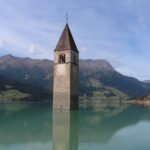
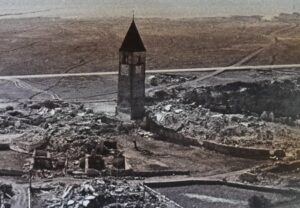 says that during winter one can still hear church bells ring, but in reality the bells were removed from the tower on July 18, 1950. The village of Curon Venosta was once a village of hundreds of people, and then it was sacrificed in the name of energy. Now, 70 years later, the lake was drained to perform some repairs to the dam. The people living in the area talked about how strange it was to walk in the ruins of the village they hadn’t seen in seven decades. Of course the sight of the village was temporary, and when the work was done, the village disappeared once again.
says that during winter one can still hear church bells ring, but in reality the bells were removed from the tower on July 18, 1950. The village of Curon Venosta was once a village of hundreds of people, and then it was sacrificed in the name of energy. Now, 70 years later, the lake was drained to perform some repairs to the dam. The people living in the area talked about how strange it was to walk in the ruins of the village they hadn’t seen in seven decades. Of course the sight of the village was temporary, and when the work was done, the village disappeared once again.

 Halley’s comet, named after astronomer Edmond Halley, only passes by Earth every 76 years or so. These days, such an event would bring excitement, viewing parties, planned trips to nearby dark sights as far from the city lights as possible, but then we know much more about comets than the people of 1910, when Halley’s Comet visited. Of course, the internet wasn’t invented in 1910, nor were computers. People only had the news paper to get their news from. This was a big story. People were so excited, that telescope sales skyrocketed as the comet neared. Hotels even offered special deals, so people could gather on top of their roofs to watch the comet pass.
Halley’s comet, named after astronomer Edmond Halley, only passes by Earth every 76 years or so. These days, such an event would bring excitement, viewing parties, planned trips to nearby dark sights as far from the city lights as possible, but then we know much more about comets than the people of 1910, when Halley’s Comet visited. Of course, the internet wasn’t invented in 1910, nor were computers. People only had the news paper to get their news from. This was a big story. People were so excited, that telescope sales skyrocketed as the comet neared. Hotels even offered special deals, so people could gather on top of their roofs to watch the comet pass.
Of course, not everyone was pleased with the comet’s appearance. There were those who believed the shooting star would end civilization. That “brainstorm” was thanks to the mind of a French astronomer named Camille Flammarion, who believed the comet’s 24-million-mile long tail contained a poisonous cyanogen gas that “would impregnate the atmosphere and possibly snuff out all life on the planet” and and while the idea was totally crazy, many unsuspecting people believed the story and it caused chaos.
Part of the problem with misinformation is that some people…especially new media, known for the idea of sensationalistic stories that are scary enough or wild enough to sell papers, or in this day and age, airtime, whether the story is true, credible, or even honest. To the news media, truth is not the most important part of a story. You have to be able to catch the eyes, and hold the imaginations of the people or the story will quickly 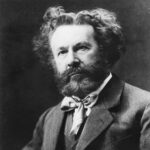 be relegated to the back of the paper. Unfortunately, The New York Times’ piece on Flammarion’s apocalyptic theory encouraged some less-trustworthy newspapers to run wild with the story. Following the story’s breaking, in addition to telescopes, people started ransacking stores for gas masks. Con men, or as we call them today, scammers made a killing by selling anti-comet pills, and some people worried the comet would “cause the Pacific to change basins with the Atlantic” and turn the world into “one heterogeneous mass of chaotic confusion.” Worried parishioners flocked to their churches, and according to science writer Matt Simon, people actually sealed up their keyholes to keep poison out of their homes.
be relegated to the back of the paper. Unfortunately, The New York Times’ piece on Flammarion’s apocalyptic theory encouraged some less-trustworthy newspapers to run wild with the story. Following the story’s breaking, in addition to telescopes, people started ransacking stores for gas masks. Con men, or as we call them today, scammers made a killing by selling anti-comet pills, and some people worried the comet would “cause the Pacific to change basins with the Atlantic” and turn the world into “one heterogeneous mass of chaotic confusion.” Worried parishioners flocked to their churches, and according to science writer Matt Simon, people actually sealed up their keyholes to keep poison out of their homes.
When the event was over, and the comet had passed, however, the gas masks proved totally worthless, because…well, there was no poison. Sure, a few people blamed the meteor for King Edward VII’s death, but there’s not a lot of science backing that claim. My guess is that the media was behind that theory too, as a way of keeping the panic alive. Interestingly, Mark Twain also passed away Of a heart attack, from a known heart condition, as the comet flew overhead, but he had refused medical help for the condition saying that, “I came in with Halley’s Comet in 1835. It is coming again next year, and I expect to go out with it. It will be the greatest disappointment of my life if I don’t go out with Halley’s Comet. The Almighty has said, no doubt: “Now here are these two unaccountable freaks; they came in together, they must go out together.” Twain had been born as the comet last flew by, in 1835.
Twain and King Edward VII were not the only death that the comet can take credit for, or should we say be associated with. The media sensationalism caused a number of people to commit suicide out of fear of the supposed coming chemical chaotic after effects of the tail of the comet. People were worried about dying a slow 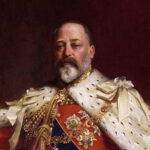
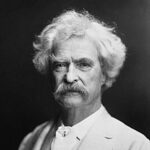 and painful death by way of the poisonous cyanogen gas that was predicted by Flammarion and The New York Times. Their combined irresponsibility cause such horrible chaos, and yet they walked off scot free, while lives were lost due to their blatant irresponsibility. Most people know that you don’t stand up and yell, “Fire!!” in a crowded theater, but somehow they totally miss the point when it comes to scaring people just to sell a newspaper. The Earth’s May 19, 1910 passing through the tail of Halley’s Comet, while a very cool event, was nothing more than just that…a very cool event.
and painful death by way of the poisonous cyanogen gas that was predicted by Flammarion and The New York Times. Their combined irresponsibility cause such horrible chaos, and yet they walked off scot free, while lives were lost due to their blatant irresponsibility. Most people know that you don’t stand up and yell, “Fire!!” in a crowded theater, but somehow they totally miss the point when it comes to scaring people just to sell a newspaper. The Earth’s May 19, 1910 passing through the tail of Halley’s Comet, while a very cool event, was nothing more than just that…a very cool event.
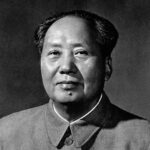
 When people doesn’t understand the world around themselves, huge mistakes can be made that affect the world, or at least a good part of it, for a long time. In 1958, Mao Zedong, the leader of the People’s Republic of China was about to make just such a mistake. In a move he called The Great Leap Forward, designed to reconstruct the country from an agrarian economy into large-scale industrialization. Part of this was the Four Pests campaign against flies, mosquitoes, rats, and sparrows. Now I can understand why Zedong considered flies, mosquitoes, and rats pests, but sparrows not so much, although, I suppose some people might disagree with me.
When people doesn’t understand the world around themselves, huge mistakes can be made that affect the world, or at least a good part of it, for a long time. In 1958, Mao Zedong, the leader of the People’s Republic of China was about to make just such a mistake. In a move he called The Great Leap Forward, designed to reconstruct the country from an agrarian economy into large-scale industrialization. Part of this was the Four Pests campaign against flies, mosquitoes, rats, and sparrows. Now I can understand why Zedong considered flies, mosquitoes, and rats pests, but sparrows not so much, although, I suppose some people might disagree with me.
Zedong basically told his nation to take pots and pans to kill all the sparrows. His campaign was successful. Millions of sparrows were killed, but this left crops vulnerable to locusts…normally kept under control by the sparrows. This agricultural policy, poor weather, and famine led to the deaths of 45 million people. Among all the incidents of mass murder caused by states in the 20th century, probably the least known in the English-speaking world is the Great Leap Forward of Mao Zedong. For some reason, the Great Leap Forward was considered somehow important enough to earn a place in the Black Book of Communism, in a description so horrifying it would haunt anyone who read about it.
Looking back on the process, so many things were done wrong. First, the rulers presumed to know a better path, when indeed, they knew nothing about what they were doing. Then, to make matters worse, they beat the population into submission in order that the plan could be implemented. The plan was intensified by a wild political enthusiasm among the population. For some reason, or maybe like the Nazis, the citizen enforcers were often worse than the tyrants at the top. In the famine that followed…well, most of us have no idea what went on. For example, all livestock was eaten or died, and the pillaging of property effectively ended the possibility of domesticating animals. Before long, there were no animals. Something we don’t think about, nor will I go into detail, there was no fat for cooking whatever food was left. People were dying, and well…corpses were used for fat as needed. Think about this the next time you prepare dinner. Think of cooking without oils at all, no butter, corn oil, bacon, or any other fat at all. Be thankful for markets that make oil, butter, and such. Things shouldn’t be taken for granted.
China’s “Great Leap Forward” in 1958-1961 became one of the worse disasters in human history. The dis hewn of deeply misguided industrialization and food procurement policies led to the deaths of around thirty-five million people from starvation and prevented the births of perhaps forty million more. Weather conditions were not unusual in these years; the famine was entirely man-made. Zedong and his fellow leaders were determined to show the superiority of communism, to quickly overtake production levels in Russia and in Britain, and to establish Mao’s leadership of the communist world. Outlandish production targets were set to match the food needs of rapidly industrializing cities and to earn foreign exchange through exports of food. Under the totalitarian system maintained by the Communist Party of China, rural communes competed to exaggerate their output, further inflating the already unattainable procurement quotas and leaving nothing for the people to eat. The Communist Party caused further chaos in the countryside by ordering that all private land be turned into communes, confiscating private property and even private cooking utensils, and making people eat in communal kitchens.
That, as well as the enormous increases in production that were confidently expected, peasant labor was diverted to public works projects and rural steel-making plants, which achieved nothing. Travel restrictions stopped communication, meaning word of what was going on, didn’t out from getting out. The penalties for disobedience were clear. In all, three-quarters of a million people were executed in 1950-51. Still in the early years, of the revolution, the Party was widely trusted. When Zedong learned of the disasters, you would have thought he would have taken measures to save the people, but his goal was to hide the facts. He doubled down on the policies, purging the messengers, labeling them “right-deviationists,” and blaming peasants for secretly hoarding food. Anything else would have made him look like a bad leader…at least in his own mind.
If Zedong had changed course when the extent of the mass starvation first became clear to the leadership, the famine would have lasted one year and not three, and in any case there was more than enough grain in government stores to prevent everyone from starving. Life expectancy in China, which was nearly 50 in 1958, fell to below 30 in 1960; five years later, once Mao had stopped killing people, it had risen to nearly 55. Nearly a third of those born during the Great Leap Forward did not survive it.
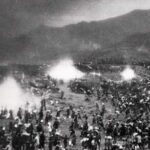

Zedong was born December 26, 1893, Shaoshan, Hunan province, China. In his political career, he was the principal Chinese Marxist theorist, soldier, and statesman who led his country’s communist revolution. Mao was the leader of the Chinese Communist Party (CCP) from 1935 until his death, and he was chairman (chief of state) of the People’s Republic of China from 1949 to 1959 and chairman of the party also until his death on September 9, 1976 in Beijing, China. I guess he survived the Great Leap Forward, unlike many of his people.

